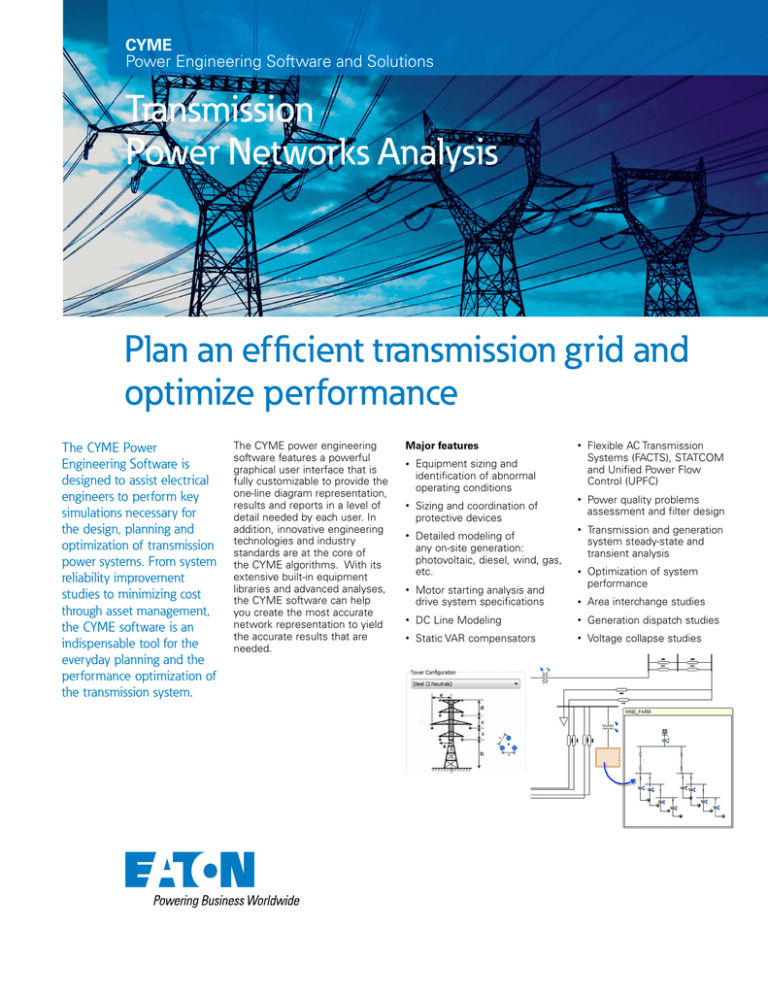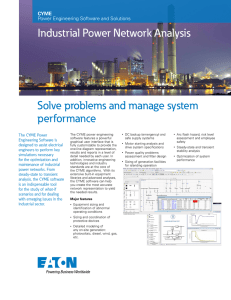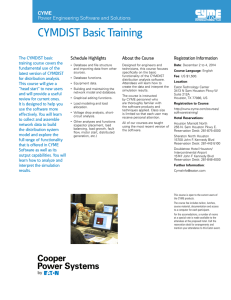
CYME
Power Engineering Software and Solutions
Transmission
Power Networks Analysis
Plan an efficient transmission grid and
optimize performance
The CYME Power
Engineering Software is
designed to assist electrical
engineers to perform key
simulations necessary for
the design, planning and
optimization of transmission
power systems. From system
reliability improvement
studies to minimizing cost
through asset management,
the CYME software is an
indispensable tool for the
everyday planning and the
performance optimization of
the transmission system.
The CYME power engineering
software features a powerful
graphical user interface that is
fully customizable to provide the
one-line diagram representation,
results and reports in a level of
detail needed by each user. In
addition, innovative engineering
technologies and industry
standards are at the core of
the CYME algorithms. With its
extensive built-in equipment
libraries and advanced analyses,
the CYME software can help
you create the most accurate
network representation to yield
the accurate results that are
needed.
•
Flexible AC Transmission
Systems (FACTS), STATCOM
and Unified Power Flow
Control (UPFC)
•
Power quality problems
assessment and filter design
•
Transmission and generation
system steady-state and
transient analysis
•
Motor starting analysis and
drive system specifications
Optimization of system
performance
•
Area interchange studies
•
DC Line Modeling
•
Generation dispatch studies
•
Static VAR compensators
•
Voltage collapse studies
Major features
•
Equipment sizing and
identification of abnormal
operating conditions
•
Sizing and coordination of
protective devices
•
Detailed modeling of
any on-site generation:
photovoltaic, diesel, wind, gas,
etc.
•
Transmission
Power
Networks
Analysis
Plan an efficient transmission
grid and optimize
performance
Network Editor
Voltage Stability
Harmonic Analysis
The CYME graphical user
interface provides great flexibility
in the creation of the one-line
diagram.
The Voltage Stability module
assesses the ability of a
power system to maintain
stable voltages under different
contingencies and loading
conditions.
The Harmonic Analysis module
evaluates the impact of
non-linear loads on the network.
•
•
•
Extensive equipment library
of cables, conductors,
generators, motors and
protective devices
Single and double circuit
overhead lines and cables
parameters estimation from
conductors’ characteristics and
layout
Customize display and
reporting functions
Power Flow
The Power Flow Analysis is the
main analysis tool for the design,
planning and operation of any
electrical power system.
•
Multiple solution algorithms
•
Simulation of islanded
networks
•
•
Phase shifting and reactive
power transformers
Abnormal conditions for
voltage limit and equipment
rating violations
Fault Analysis
The Fault Analysis module
assesses the effects of
different types of short-circuits,
evaluates fault contributions
from machines and helps the
verification of equipment rating.
•
Supports conventional shortcircuit studies and adheres to:
IEC-60909©, ANSI® C37.5,
ANSI® C37.010, ANSI® C37.13
•
Shunt, series and
simultaneous faults
calculations.
•
Identify possible fault locations
from recorded current
measurement
•
•
Modeling of harmonic
equipment and sources
Study load scaling scenarios
•
Frequency scan analysis
•
Generator dispatch to match
load increase
•
•
Generate PV curves
Harmonic voltage and current
distortion calculations (THD,
IHD, TIF, ITIF)
•
K-factor calculation
•
Capacitor rating and filter
sizing analysis
•
Optimal Power Flow
The Optimal Power Flow is a
module for the optimization of
system performance through the
study of planning alternatives
and system control strategies.
•
Minimize system losses and
generation cost
•
Voltage collapse analysis
•
Load transfer capability
investigation
Transient Stability
The Transient Stability Analysis
module is a time-series analysis
to simulate electromechanical
transients in electrical power
systems.
•
Dynamic models of equipment
and controls
•
Voltage, over-current and
frequency operated relays
with trip signals to controlled
breakers
•
Test the step response of
controllers during events such
as faults, switching and load
shedding
Load Flow Contingency
The Load Flow Contingency
module allows the study of
what-if scenarios up to N-p
contingencies to establish
optimal network operation.
•
Process sequential
contingency studies in a single
batch run
•
Create a group of up to N-3
outages contingency
•
Automatic computation of
voltage and overload indices
to identify the most severe
contingencies
Additional Modules
Additional modules, such as
the COM module and the
Scripting Tool with Python
module, offer capabilities that
further assist in batch analysis
and the automation of the
simulation process. Please refer
to our website for additional
information on each of the
following modules:
•
Protective Device Analysis
•
Python Scripting
•
Advanced Project Manager
•
Component Object Modeling
•
Geographic Overlay
Equipment Rating Verification
functionality to assess if
equipment are properly rated
Eaton
1000 Eaton Boulevard
Cleveland, OH 44122
United States
Eaton.com
CYME International T&D
1485 Roberval, Suite 104
St.Bruno, QC, Canada J3V 3P8
P: 450.461.3655 F: 450.461.0966
P: 800.361.3627 (Canada/USA)
CymeInfo@eaton.com
www.eaton.com/cyme
© 2015 Eaton All Rights Reserved
Printed in Canada
Publication No. BR 917 048 EN
March 2015
Eaton is a registered trademark.
All other trademarks are property
of their respective owners.
Follow us on social media to get the
latest product and support information.












